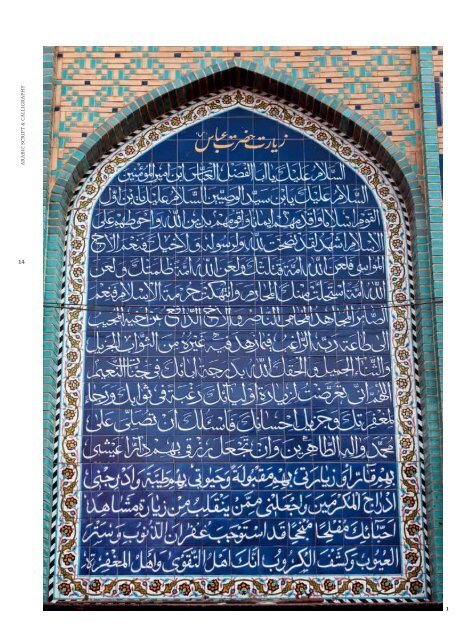Arabic Graffiti - Allcity
Arabic Graffiti - Allcity
Arabic Graffiti - Allcity
- No tags were found...
Create successful ePaper yourself
Turn your PDF publications into a flip-book with our unique Google optimized e-Paper software.
arabic script & calligraphy1 . 2Brief History ofthe <strong>Arabic</strong> Scriptby Huda Smitshuijzen AbiFarès14 The rich <strong>Arabic</strong> calligraphic traditionhas had a long and influential history in shaping and regulating the visual aspect of1. Prayer inscribed on tiles in a mosque.Title written in Farsi script, prayer inThuluth script. Iranthe <strong>Arabic</strong> script. Originally conceived to represent the holy scriptures of the Koran, the<strong>Arabic</strong> script became an emblem of the Islamic religion, and therefore, its perceived beautyand reproduction became a matter of religious piety. Not only used for representing religioustext, its use in profane texts and its function as ornamentation on everyday objectsand architecture testifies to its special status within the Arab/Islamic cultures. It is a partof a holistic life philosophy in which artistic expression plays a vital role.15The <strong>Arabic</strong> alphabet evolved by first borrowing from neighboring civilizations and thendeveloping in its own right as an independent script. With the collective contribution ofmany talented individuals and the influences of various cultures, calligraphy developedinto a form of communication that balanced clarity with beauty in an art form that embodieddisciplined freedom. The <strong>Arabic</strong> alphabet, like most alphabetic writing systems inuse today, has its roots in the first developed alphabetic writing system invented around1300 BCE by the Phoenicians. The Phoenicians developed a simple and limited set of phoneticcharacters that were easy to learn and adapt to various languages. As traders, thePhoenicians managed to spread the alphabet across their trade routes and port cities. Theinvention of the alphabet spread westward via the Greeks and eastward via the Aramaeansas far as India, and was adopted as a writing system by various Semitic, Indo-Europeanand other languages. The <strong>Arabic</strong> alphabet, born in Arabia, is the last of the Semitic scripts(c. 500 CE). From its origin on the Arabian Peninsula, the <strong>Arabic</strong> language spread via theIslamic conquests to neighboring nations, into what constitutes the Arab/Islamic nationsof today. As a language, it has replaced a number of native languages and was adopted bynon-<strong>Arabic</strong> languages as a visible cultural allegiance to the Islamic faith. The <strong>Arabic</strong> languagebecame a unifying cultural force, and its visual representation through calligraphybecame the supreme artistic achievement of Islamic art.1
















